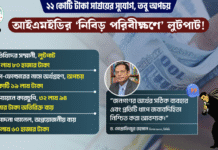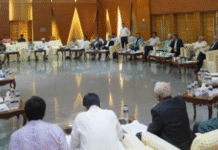Can Bangla Nationalism Counter Hindi-Hindu Nationalism in Bengal?
A new brand of cultural politics calibrated to establish the dominance and supremacy of Bengali language and culture is on the rise in the state. What its consequences will be are unpredictable.

Will linguistic nationalism be an effective counter to the rising tide of religious nationalism in the state? Illustration: Pariplab Chakraborty
“If you are coming to Bengal, you have to speak in Bengali. We would not allow that people will
come from outside and beat up Bengalis,” Mamata Banerjee said at a recent meeting as passions ran high with striking junior doctors continuing to keep away from work.
Arguably, in the coming weeks and months, a new brand of cultural politics is going to come into play in Bengal. A politics calibrated to establish the dominance – the supremacy even – of Bengali language and culture. The kind of politics that, in its embrace, raises several difficult and conflicting questions.

Will linguistic nationalism be an effective counter to the rising tide of religious nationalism in the state? Or will it deepen the existing polarisation at the twin poles of religion and language? Will Hindi speaking communities – they are a huge population in Bengal, a large chunk of them supporters of the Bharatiya Janata Party (BJP) – find themselves at the receiving end of a pro-Mamata, Bangla-speaking population’s ire? How will this conflict play out in a state where political violence is entrenched?
Tying politics to linguistic and cultural dominance in ordinary times has dangerous implications and Bengal is passing through extraordinary times. In times as fraught as they are now, the slogan of linguistic and cultural domination could very easily scale up tensions and aggression in unpredictable ways.
Banerjee is known for her impassioned love for Bengal, her unequivocal emotional bonding with Bangla language and culture. Her party’s slogan – Ma, maati, maanush – was born out of this bond. Yet, though prone to emotional indulgence, Banerjee has not leveraged Bengali linguistic and cultural nationalism as a potent weapon to outdo her adversaries in the past.
Put differently, it may be argued that prior to this moment, she never needed to use such a strategy against her adversaries. Though a substantive chunk of them are upper class and Western-educated, the Communist Party of India (Marxist) (CPI(M)) leadership, was politically rooted in Bengal – making the deployment of cultural nationalism unnecessary. Against them, Banerjee leaned on other kinds of Bengali identity, as the slogan indicates.
Also Read: While Bengal Is in Turmoil, Men Explain Marxism to Me
Banerjee’s new adversary, the BJP, on the other hand, is generally perceived to be a party of “outsiders,” with its core support base lodged in India’s Hindi heartland. In popular consciousness, the BJP stands for Hindi-Hindu politics.
But many would argue – justifiably – that the roots of Hindu consolidation run deep in Bengal. That the silent presence of a network of Hindu organisations, working at the grassroots since the 1930s, has nurtured and nourished those roots. The course of history might have led to the dominance of Communist politics, the installation of a Left Front government, and its incredibly long rule in the state. But networks of Hindu groups consolidated themselves as a subterranean presence throughout this period, even as in the popular imagination, Bengal was seen as the ultimate secular state.
As the political situation changes, Bengal’s fault-lines – and there are many – are beginning to deepen and reveal themselves. Street chatter across Kolkata is becoming increasingly polarising. I hear people freely venting their prejudices in ways I never have before. Unlike in the past, offensive language is no longer confined to drawing rooms. Airing their anger in public, Bengali Hindus pick on two communities – Muslims and Biharis – as primary targets of their hostility. Banerjee, too, is a prime target of such disaffection.
The reasons for dumping Banerjee and embracing the BJP have little to do with customary anti-incumbency grievances. Banerjee is not in the dock for failing to deliver what she promised. Rather, if the TMC’s corruption is a prickly issue, a far bigger and potent matter is the chief minister’s so-called Muslim “appeasement” policy. Four out of every five people I talk to paint the entire Muslim community with broad strokes of criminality.
Cutting across classes – from a working class cab driver, and a roadside chaiwallah, to a middle class professional (of a broadly left-liberal disposition) – people in Kolkata, verbalise a shared sentiment: “Awther (Muslims) bhishon baar berechche” (They have started to get too ahead of themselves.)
At the centre of this “us vs them” narrative stand Banerjee and her administration, seen to be patronising Muslim “criminals”. One of the most common stories one hears in Kolkata has to do with the way in which the police looks the other way, allowing Muslims to break rules and create lawlessness. “This is not an administration for Hindus. Didi does nothing for us. The police fines only Hindus for breaking traffic rules while Muslim bikers dash around the city with impunity,” says Shobhan, a cab driver.
Also Read: Will Mamata Banerjee Invoke Bengali Cultural ‘Asmita’ to Push Back the BJP?

A BJP rally in the Hooghly Lok Sabha constituency. Credit: Twitter/BJP Bengal
People from the middle-classes, too, spend a lot of time talking about suspicious and lawless Muslim bikers zooming around the city. People in Kolkata routinely tell me how Muslims choose to live in ghettos, crowding, and littering their surroundings. The fact that landlords are often reluctant to rent out places to Muslims, and that their low economic status pushes many middle-class areas out of their reach, do not figure in these conversations.
While Muslims, like all other communities, are bound to have their share of criminal elements, a popular narrative built around an entire community not only indicts that community but creates fertile ground for communal violence. It needs to be said, in this context, that the Muslim community is not homogeneous. Making them so only plays into the hands of divisive forces. But the repeated invocation of monolithic ideas of Muslim criminality do speak to how bad things are getting in the present turmoil.
Alongside this narrative about Muslims, there is also burgeoning hostility against working class Biharis. As I shared a ride with two women in a cab the other day, one of them heaped insults on migrants from Bihar. Not the least bit concerned that our driver was from Bihar, she rattled off a number of grievances against the community. “Bengal is the only state where you can come and work. No other state welcomes you the way we do. But you are spoiling the city and our culture,” she vented.
It is, of course, not the affluent Marwaris and Gujaratis – business communities who replaced the Bengali aristocracy (at least in terms of occupying prime real estate in the city) – who are at the receiving end of popular anger. Instead, working men and women from Bihar are perceived to be sullying Bengal’s culture.
It is against this backdrop of unravelling tensions that we must situate Banerjee’s latest statement about Bengali language and culture. Groups like Bangla Pakkha (the Bengali Side,) with a large social media presence, which strongly promote Bangla, seem to be influencing Banerjee’s political strategy.
A section of Kolkata’s intellectuals believe the moment has arrived to retrieve Bengal’s forgotten and lost glory. They also believe that popularising Bangla would create a kind of Bengali identity that can withstand the majoritarian nationalism the BJP promotes wherever it goes.
But this is a dangerous game to play and the fires being lit might be harder to put out than Banerjee imagines. Nor does it help that the entire spectrum of non-BJP political parties in the state has either gone into a mode of withdrawal or silent complicity in the hopes of watching Banerjee walk a political tightrope.
Also Read: While BJP Goes All Out to Consolidate Strength in Bengal, TMC Appears at a Loss
Even as there is need for tremendous caution around the precarious nationalist politics Banerjee is playing, there is also a need to recognise that the doctor’s strike – legitimate concerns notwithstanding – is not quite entirely what it appears to be. It would be a mistake to think that Left and Right alike are not fanning the flames of their discontent in irresponsible ways.
We are yet to see where these diverse political machinations will lead. But the outcome is unlikely to be a happy one.
The article appeared in thethewire.in on 17 June 2019










